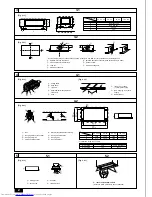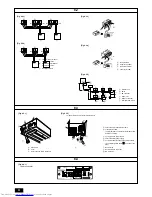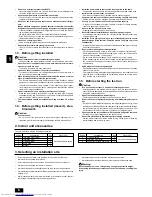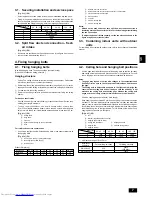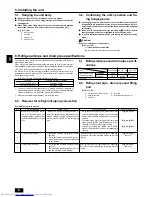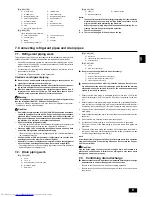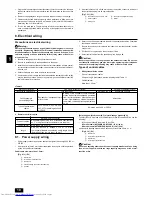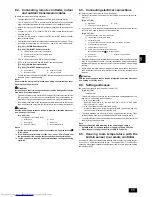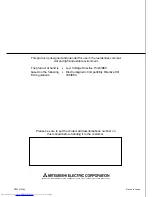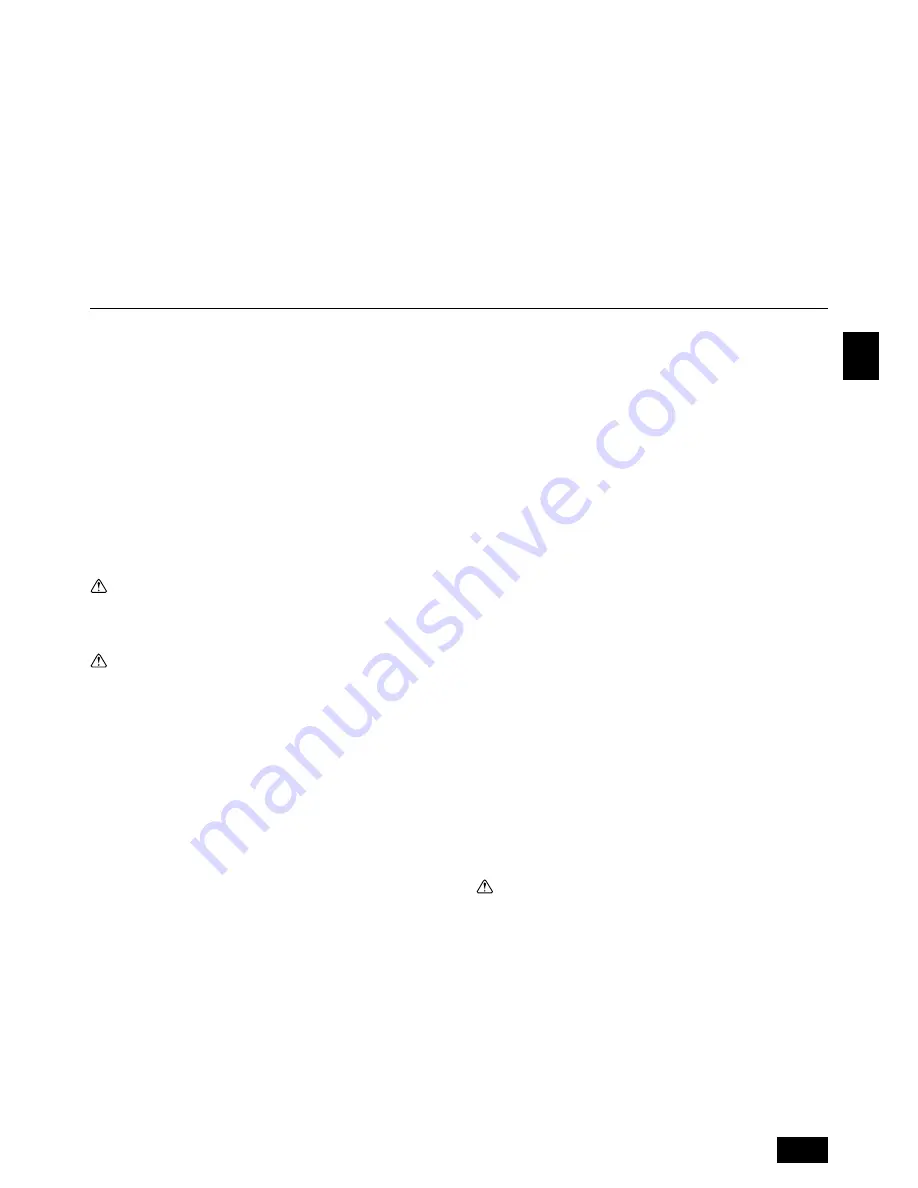
9
GB
D
F
I
NL
E
P
GR
RU
TR
[Fig. 6.3.1]
(P.3)
A
“0-0 gas” mark
B
“INNER” mark
C
“OUTER” mark
D
Flare insulation (2)
E
Refrigerant piping (gas)
F
Refrigerant piping (liquid)
G
Field refrigerant piping
H
Pipe insulation (1)
I
Insulation material
J
Flare
K
Pull in this direction.
L
Insulation material
M
Flare
N
There must be no gap.
O
Move to the original position.
[Fig. 6.3.2]
(P.3)
(figure showing the flare insulation)
A
Field refrigerant piping
B
There must be no gap.
C
Unit body plate
D
OUTER
E
INNER
F
Unit body
G
Provided flare insulation (2)
[Fig. 6.3.3]
(P.3)
A
Tape (3)
B
Fasten with tape.
C
Provided tie band (4)
Notes:
*1
Insert the flare nut into the field refrigerant piping. Pull the insulation
material back at the area where it will be flared, then return it to its
original position after performing the flare work.
Exposing copper piping may result in condensation forming. Be ex-
tremely careful when performing this operation.
*2
There must be no gap.
*3, *4 There must be no gap. Slit should be on the top.
7. Connecting refrigerant pipes and drain pipes
7.1. Refrigerant piping work
This piping work must be done in accordance with the installation manuals for both
outdoor unit and BC controller (simultaneous cooling and heating series R2).
•
Series R2 is designed to operate in a system that the refrigerant pipe from an
outdoor unit is received by BC controller and branches at the BC controller to
connect between indoor units.
•
For constraints on pipe length and allowable difference of elevation, refer to
the outdoor unit manual.
•
The method of pipe connection is flare connection.
Cautions on refrigerant piping
s
s
s
s
s
Be sure to use non-oxidative brazing for brazing to ensure that no for-
eign matter or moisture enter into the pipe.
s
s
s
s
s
Be sure to apply refrigerating machine oil over the flare connection seat-
ing surface and tighten the connection using a double spanner.
s
s
s
s
s
Provide a metal brace to support the refrigerant pipe so that no load is
imparted to the indoor unit end pipe. This metal brace should be pro-
vided 50 cm away from the indoor unit’s flare connection.
Warning:
When installing and moving the unit, do not charge it with refrigerant other
than the refrigerant (R407C or R22) specified on the unit.
- Mixing of a different refrigerant, air, etc. may cause the refrigerant cycle to mal-
function and result in severe damage.
Caution:
• Use refrigerant piping made of C1220 (CU-DHP) phosphorus deoxidized
copper as specified in the JIS H3300 “Copper and copper alloy seamless
pipes and tubes”. In addition, be sure that the inner and outer surfaces of
the pipes are clean and free of hazardous sulphur, oxides, dust/dirt, shav-
ing particles, oils, moisture, or any other contaminant.
• Never use existing refrigerant piping.
- The large amount of chlorine in conventional refrigerant and refrigerator oil
in the existing piping will cause the new refrigerant to deteriorate.
• Store the piping to be used during installation indoors and keep both
ends of the piping sealed until just before brazing.
- If dust, dirt, or water gets into the refrigerant cycle, the oil will deteriorate and
the compressor may fail.
• Use Suniso 4GS or 3GS (small amount) refrigerator oil to coat the flare
and flange connection part. (For models using R22)
• Use ester oil, ether oil or alkylbenzene (small amount) as the refrigerator
oil to coat flares and flange connections. (For models using R407C)
- The refrigerant used in the unit is highly hygroscopic and mixes with water
and will degrade the refrigerator oil.
7.2. Drain piping work
[Fig. 7.2.1] (P.3)
A: 25 cm
B: 1.5 – 2 m
A
Downward pitch of more than 1/100
B
Insulating material
C
Metal brace
[Fig. 7.2.2] (P.3)
D
Indoor unit
E
Take as large as possible. About 10 cm
F
Collected pipes
[Fig. 7.2.3] (P.3)
C: 30 cm
G
Drain hose (Accessory)
s
s
s
s
s
Be sure to use the supplied drain hose (Accessory).
H
Less than 300 mm
I
Hard vinyl chloride 90° elbow (field supply)
J
Hard vinyl chloride (VP-25) (field supply)
K
Tie band (small) (Accessory)
s
s
s
s
s
Connect each connection with vinyl chloride adhesive. But never use
any adhesive over the indoor unit discharge port. Otherwise the drain-up
mechanism cannot be serviced later. Also, the end connection may be
eroded by resin and so cracked.
1. Ensure that the drain piping is downward (pitch of more than 1/100) to the
outdoor (discharge) side. Do not provide any trap or irregularity on the way.
(
1
)
2. Ensure that any cross-wise drain piping is less than 20 m (excluding the differ-
ence of elevation). If the drain piping is long, provide metal braces to prevent it
from waving. Never provide any air vent pipe. Otherwise drain may be ejected.
3. Use a hard vinyl chloride pipe VP-25 (with an external diameter of 32 mm) for
drain piping.
4. Ensure that collected pipes are 10 cm lower than the unit body’s drain port as
shown in
2
.
5. Do not provide any odor trap at the drain discharge port.
6. Put the end of the drain piping in a position where no odor is generated.
7. Do not put the end of the drain piping in any drain where ionic gases are
generated.
8. The intake of the drain piping can be made 30 cm higher than the drain dis-
charge port. If there are some obstacles under the ceiling, use elbows to make
it at least height according to the site. (
3
)
Note:
If the rise portion is long, there will be a lot of returned water in an operation
stop, generating slime or odor during off-season. Ensure that the rise por-
tion is at a minimum.
Caution:
Pipe the drain piping to ensure that it discharges drain, and insulate it to
prevent dew condensation. A failure to the piping work may cause water
leakage and so wet your property.
7.3. Confirming drain discharge
s
s
s
s
s
Make sure that the drain-up mechanism operates normally for discharge
and that there is no water leakage from the connections.
•
Be sure to confirm the above in a period of heating operation.
•
Be sure to confirm the above before ceiling work is done in the case of a new
construction.


